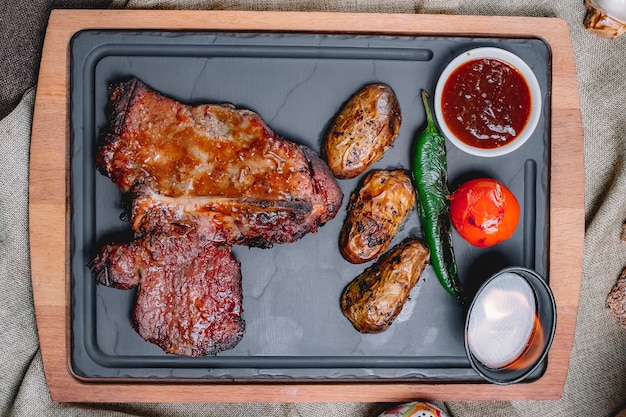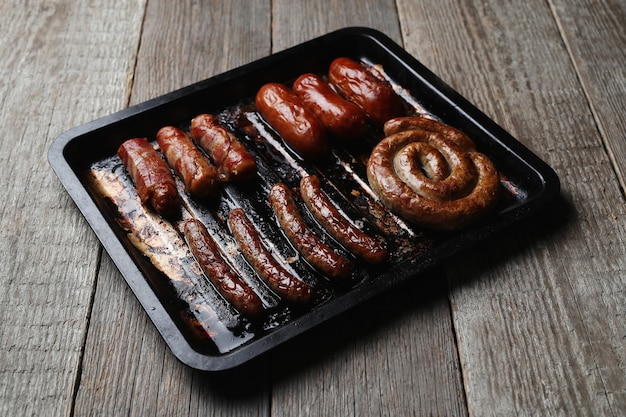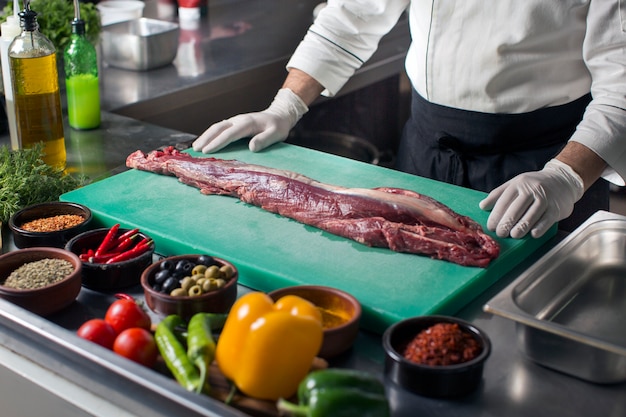Ah, ribs. There's something truly magical about the way they melt in your mouth, the way the smoky flavour dances on your tongue, the way they make you feel like you're in barbecue heaven. And when you're talking about ribs, a Traeger smoker is practically the holy grail. It's a match made in culinary heaven. But let me tell you, getting those perfect, fall-off-the-bone ribs isn't just a matter of throwing some meat on the smoker and hoping for the best. Believe me, I've been there. There were plenty of times when my ribs came out dry, tough, and frankly, a bit disappointing. But over the years, through a lot of trial and error, I've finally cracked the code. And I'm here to share my secrets with you.
This guide is your one-stop shop for everything you need to know about cooking ribs on a Traeger. We'll cover everything from choosing the right cut of meat to mastering the smoking process, and we'll even delve into some of the most common pitfalls to avoid. I'll also share some of my favourite recipes, tips, and tricks that I've picked up along the way. So, grab a cold drink, settle in, and let's get started!
Part 1: Choosing the Right Ribs

The first step to making amazing Traeger ribs is choosing the right cut of meat. There are two main types of ribs you'll typically find at the butcher: baby back ribs and spare ribs. Each has its own unique characteristics and will affect the final outcome of your cook. Let's dive in and see which one might be best for you.
baby back ribs
Baby back ribs are the quintessential rib. They're the most popular choice for a reason. These ribs come from the upper part of the pig's back, closer to the spine. They're smaller than spare ribs, with a more tender and flavourful meat. They also have a nice, even thickness, making them easier to cook evenly. You'll typically find them packaged with the membrane still on, so make sure you remove it before cooking. That membrane can be tough and chewy, so it's best to get rid of it. It can be easily removed with a sharp knife or a specialized membrane remover tool.
Spare Ribs
Spare ribs come from the lower part of the pig's back, below the baby back ribs. They're larger and meatier than baby back ribs, which can be a big advantage if you're feeding a crowd. They have a higher fat content, which can make them a bit more flavorful, particularly if you like that rich, fatty taste. However, they also take longer to cook, and they can be a bit tougher than baby backs. Spare ribs usually have a "slab" of cartilage on the bottom, that you might want to remove before cooking. Spare ribs tend to be less expensive than baby back ribs, making them a budget-friendly option.
The Verdict:
Personally, I'm a big fan of baby back ribs. I find them to be more consistently tender and flavorful. I love that they cook quicker and offer a more delicate taste. However, spare ribs can be a great option if you're on a budget or you're looking for a more substantial meal, especially if you enjoy a more robust flavour profile. Ultimately, it comes down to your personal preference and what you're looking for in your ribs.
Part 2: Prepping the Ribs

Once you've chosen your ribs, it's time to get them prepped for smoking. This is a critical step, and it can make a huge difference in the final result. A little bit of effort upfront will pay off in spades in the end.
Removing the Membrane
The first step is to remove the membrane from the back of the ribs. The membrane is a thin, tough layer of tissue that can make the ribs tough and chewy. It's like a little protective shield for the meat, but it's not our friend when it comes to cooking. You can easily remove it with a sharp knife or a tool specifically designed for this task, like a membrane remover. To do this, make a small cut in the membrane, then use your fingers or the tool to get a good grip and pull it off in one piece.
Seasoning the Ribs
Next, you'll want to season the ribs. This is where you can really get creative. There are endless possibilities here, but I like to keep things simple. A basic rub with salt, pepper, and garlic powder is all you really need. These three ingredients alone will create a fantastic base for flavour. But if you want to take it up a notch, feel free to experiment with other seasonings, like paprika, onion powder, or even chili powder.
Tips for Seasoning Ribs:
- Don't be afraid to go heavy on the salt. Salt is a key ingredient in flavour development. It helps to draw out the moisture in the meat and enhances the overall flavour profile. Don't be shy!
- Apply the seasoning evenly to all sides of the ribs. You want to make sure that every inch of the meat is covered in seasoning.
- Rub the seasoning into the meat, don't just sprinkle it on. This will help the seasoning to adhere to the meat and penetrate deeper during the cooking process.
- You can also inject the ribs with a marinade to add extra flavour. Injecting a marinade directly into the meat will help to infuse it with flavour and create a more moist and tender rib.
- Let the ribs sit at room temperature for 30 minutes before smoking. This will allow the seasoning to penetrate the meat and help to ensure even cooking.
Part 3: Setting Up Your Traeger

Now that your ribs are prepped, it's time to set up your Traeger. Getting your smoker ready is a critical step, and a few simple adjustments can make a big difference in the quality of your ribs.
1. Preheat the Traeger
First, preheat your Traeger to 225°F (107°C). You want to make sure the smoker is nice and hot before you add the ribs. It's important to allow the smoker to reach the desired temperature before you start cooking. This helps to ensure that the ribs cook evenly and don't get stalled in the cooking process.
2. Set the Smoke
Next, you'll want to add some smoke to your Traeger. Wood chips are the key to giving your ribs that irresistible smoky flavour. There are many different types of wood chips you can use, but I like to use hickory or applewood. These woods impart a classic, balanced smoke flavour that works well with ribs. I add a handful of chips to the smoker's wood chip tray, ensuring the wood is soaked. Soaking the chips helps them to burn longer and produce a more consistent smoke.
3. Add the Ribs
Once the Traeger is preheated and the smoke is rolling, you can add the ribs. You'll want to place the ribs bone-side down on the smoker rack. This ensures that they cook evenly, as the bone acts as a heat conductor, helping to cook the meat more uniformly. I typically use a Traeger drip pan underneath the ribs to catch any drippings. This helps to keep the smoker clean and provides a nice pool of flavorful juices that you can use to baste your ribs later on.
Part 4: The Smoking Process
Now comes the fun part: smoking the ribs. This is where the magic truly happens, where those ribs transform from raw meat into melt-in-your-mouth perfection. Here's the lowdown on my approach, the tried-and-true method that has never failed me.
1. The 3-2-1 Method
I'm a big fan of the 3-2-1 method for smoking ribs. It's a simple yet effective approach that produces consistently amazing results. Here's how it works:
- Smoke for 3 hours at 225°F (107°C) with the smoker lid closed. Don't open the lid frequently, as this will cause the temperature to drop and stall the cooking process. During this stage, the smoke flavour will penetrate the meat and begin to create a delicious bark on the outside. You can check the ribs every hour, adding more wood chips to the smoker as needed.
- Wrap for 2 hours. After 3 hours, you'll want to wrap the ribs in aluminum foil. This creates a steamy environment that helps to tenderize the meat and create that melt-in-your-mouth texture. You can add a few tablespoons of apple cider vinegar or your favorite bbq sauce to the foil to add extra flavour and moisture.
- Unwrap and glaze for 1 hour. After 2 hours of wrapping, remove the foil and add your favourite barbecue sauce. Continue cooking for another hour, basting the ribs with the sauce every 30 minutes. This stage allows the ribs to develop a crispy bark and absorb the rich flavour of the sauce.
By the end of the 3-2-1 method, you should have some amazing ribs that are tender, juicy, and bursting with flavor.
2. Tips for Smoking Ribs
- Use a meat thermometer to check the internal temperature of the ribs. They're done when the internal temperature reaches 190°F (88°C). Don't rely solely on looks or feel. A meat thermometer is the most reliable way to ensure your ribs are cooked to perfection.
- Don't be afraid to experiment with different wood chips and rubs. There's a whole world of flavour to explore! Try mixing different wood chips or creating your own custom rub to find your perfect combination.
- Make sure you're using a good quality barbecue sauce. A high-quality sauce will make a huge difference in the final flavour. Look for sauces with balanced flavour profiles and ingredients that will complement your ribs.
- Keep an eye on the smoker temperature and adjust it as needed. You want to maintain a consistent temperature throughout the cooking process. This will ensure that the ribs cook evenly and don't get overcooked or undercooked.
Part 5: Resting the Ribs
After your ribs are done cooking, it's crucial to give them a good rest. This allows the juices to redistribute throughout the meat, making for a more tender and flavorful result. It also helps to prevent the ribs from drying out.
How to Rest Ribs
- Remove the ribs from the smoker and wrap them tightly in aluminum foil. This will create a steamy environment that helps to keep the meat moist and tender.
- Let them rest for at least 30 minutes, but up to an hour. The longer you let them rest, the more the juices will redistribute.
Part 6: Slicing and Serving
Now that your ribs have rested, you're ready to slice and serve. Here's a simple approach for slicing ribs for the best results.
How to Slice Ribs
- Use a sharp knife to slice the ribs between the bones. A sharp knife will make clean cuts and prevent the meat from tearing or shredding.
- Cut each rib into individual pieces. This makes it easier to eat and prevents the ribs from being too large.
- Arrange the ribs on a platter and serve them with your favourite sides. You can also add a dollop of sauce on top of each rib for extra flavour.
Delicious side dishes for Ribs:
- Macaroni and Cheese - A classic pairing for ribs, mac and cheese adds a creamy and comforting element to the meal.
- Baked Beans - Sweet and smoky, baked beans are the perfect complement to ribs, offering a contrasting flavour and texture.
- Coleslaw - A refreshing and crunchy side dish, coleslaw provides a nice contrast to the richness of the ribs.
- potato salad - Creamy and hearty, potato salad is a classic barbecue side dish that always goes well with ribs.
- corn on the cob - Sweet and juicy, corn on the cob is a seasonal treat that adds a burst of freshness to any rib meal.
Part 7: FAQs
So you've got your smoker fired up, you've chosen your ribs, and you're ready to cook. But you might still have some questions. Here are some common questions about Traeger ribs, and my answers.
1. What's the best way to tell if ribs are done?
The best way to tell if ribs are done is to use a meat thermometer. You want the internal temperature of the ribs to reach 190°F (88°C). You can also check for tenderness by gently tugging on a rib bone. If it comes away easily, the ribs are done. However, a meat thermometer is the most reliable way to ensure they're cooked through.
2. How do I know if my Traeger is hot enough?
The best way to check the temperature of your Traeger is to use a meat thermometer. You can also use the Traeger's built-in temperature gauge, but it's not always the most accurate. I prefer using a separate thermometer for my smoker. This gives me a more precise reading and ensures that my smoker is maintaining the correct temperature.
3. Can I use a different smoker than a Traeger?
Absolutely! You can cook ribs in any type of smoker, including offset smokers, charcoal smokers, and even a gas grill. The 3-2-1 method works for any smoker. The key is to maintain a consistent temperature and smoke throughout the cooking process.
4. What's the best barbecue sauce for ribs?
That's a matter of personal preference. I like to use a sauce with a good balance of sweet, smoky, and tangy flavors. There are many great barbecue sauces on the market, so experiment and find your favorite.
5. How do I store leftover ribs?
Store leftover ribs in an airtight container in the refrigerator for up to 3 days. You can also freeze them for up to 3 months. Reheat them in the oven or microwave until they're heated through.
Part 8: My Favourite Traeger ribs recipe
Okay, you're ready to make some incredible ribs? Here's my go-to recipe, and it never fails to impress. This recipe is simple to follow and produces consistently delicious results.
Ingredients:
- 3 racks of baby back ribs (about 3 pounds each) - You can use spare ribs if you prefer, but adjust cooking time accordingly.
- 1 tablespoon salt - This is a key ingredient for flavor development.
- 1 tablespoon black pepper - Adds a bit of heat and complexity to the rub.
- 1 tablespoon garlic powder - Provides a savory and aromatic flavour.
- 1 tablespoon paprika - Adds a touch of sweetness and a vibrant colour to the rub.
- 1 tablespoon onion powder - Enhances the overall flavour profile with a hint of sweetness and umami.
- 1/2 tablespoon chili powder - Adds a gentle kick of heat and a touch of smokiness. Adjust to your desired spice level.
- 1/2 cup apple cider vinegar - This will be added to the foil during the wrapping stage for extra moisture and flavour.
- 1 cup your favorite barbecue sauce - Choose a sauce with a good balance of sweet, smoky, and tangy flavours.
Instructions:
- Remove the membrane from the back of the ribs.
- Combine the salt, pepper, garlic powder, paprika, onion powder, and chili powder in a small bowl.
- Rub the seasoning evenly onto all sides of the ribs.
- Preheat your Traeger to 225°F (107°C).
- Add a handful of hickory or applewood chips to the smoker's wood chip tray.
- Place the ribs bone-side down on the smoker rack.
- Smoke the ribs for 3 hours at 225°F (107°C).
- Wrap the ribs tightly in aluminum foil. Add a few tablespoons of apple cider vinegar to the foil.
- Continue cooking for 2 hours wrapped in foil.
- Unwrap the ribs and brush with your favourite barbecue sauce.
- Continue cooking for 1 hour, basting the ribs with sauce every 30 minutes.
- Remove the ribs from the smoker and let them rest for at least 30 minutes.
- Slice the ribs between the bones and serve.
Part 9: A Final Word
There you have it, the ultimate guide to Traeger ribs. With a little practice and a few helpful tips, you'll be turning out mouthwatering ribs in no time. Whether you're a seasoned smoker or just getting started, I hope this guide gives you the confidence to tackle your next rib cookout. So fire up that Traeger, grab some friends, and enjoy the amazing results. Happy smoking!
Everyone is watching

Corn on the Cob: The Ultimate Guide to Perfectly Cooked Ears
Healthy MealsAh, corn on the cob. Just the name evokes images of sunny days, barbecues, and that sweet, juicy flavour that ...

Perfect Pork Roast Oven Cooking Time: A Guide to Delicious Results
Healthy MealsThere's something truly satisfying about a perfectly roasted pork. The aroma alone is enough to make your mout...

Ham Cooking Time: How Long to Bake, Smoke, or Boil a Delicious Ham
Healthy MealsAh, ham. It's a classic, isn't it? A real crowd-pleaser, especially around holidays. And when done right, it'...

Scallops: The Ultimate Guide to Perfect Cooking
Healthy MealsAh, scallops. Those delicate, sweet, and utterly delicious morsels of the sea. They hold a special place in my...

Spaghetti Squash: The Ultimate Guide to Cooking and Serving
Healthy MealsRemember that time you saw spaghetti squash at the supermarket, looking all bumpy and strange, and thought, "W...
